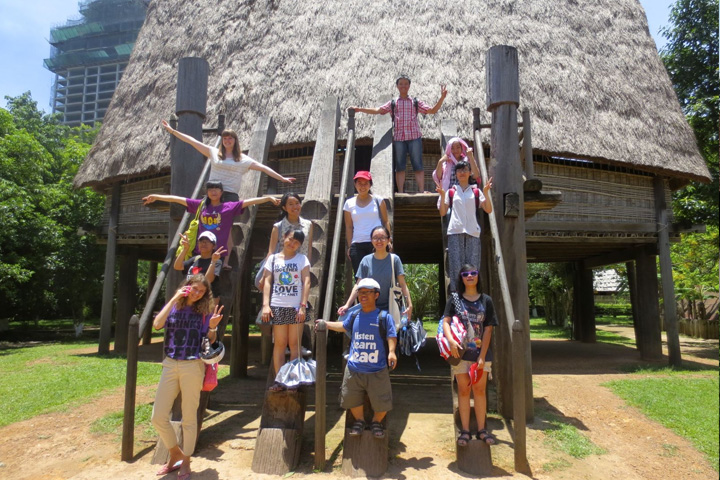The Vietnamese – a seemingly clear conception which suddenly poses a thorny question if we dig deeper through the prejudices ingrained in our genes: what is Vietnamese? And in Vietnam, there is no better way than Vietnam Museum of Ethnology where you could be provided an overview on Vietnamese, and based on that, build your own conception.

Vietnam Museum of ethnology
The history of Vietnam Museum of Ethnology:
The museum was conceived a long time ago, back to 1980s when Vietnamese people just stepped out of the devastating war. Not until 12/11/1997, the museum officially opened to the public in its inauguration joined by former Vietnam vice president Nguyen Thi Binh and former France president Jacques Chirac. Nowadays, highly suggested by Tripadvisor, the museum has attracted many domestic and international tourists visiting each day.

House model in outdoor area in Hanoi ethnology museum
How to get there
Located on Nguyen Van Huyen street, Cau Giay district, Vietnam Museum of Ethnology is easy to be reached. Public transport is also available with various buses that would take you there. Check the bus map of Hanoi to find the suitable bus to get there. From Dinh Tien Hoang street (along Hoan Kiem lake) take bus No.14 to get there. The more convenient way is getting a taxi which cost about 100.000 VND (approximately $5) and ttakes30 minutes from old quarter.
What to visit
The Museum has three distinct areas serving different purposes.
The Dong Son Drum building – indoor area
should be the first to visit. It was designed by Ha Duc Linh, a Tay minority; and the interior architecture was designed by a French architect, Ms. Veronique Dollfus. The first floor provides you an overview of Vietnam’s 54 ethnic groups: the Viet (Kinh) and 53 minority groups, who together speak languages spread across five linguistic families.

Daily artifact of Kinh (Viet) people
And the rest of the first floor is dedicated to illustrating everyday lives of the Viet and Muong – Tho – Chut. The second floor exhibits Cham – Hoa – Khmers, Mon – Khmers, Sino – Tibetian, Hmong – Yao, Tai – Kadai. 15000 artifacts, 42000 pictures, 373 videos, 25 CD Rom and numerous records labeled in English, French and Vietnamese throughout, are both comprehensive and fascinating, covering all the main minority groups. Plentiful audiovisual displays are offered along with more typical museum fare and dioramas. Some items on display are simply breathtaking. Sometimes, the exhibition topics are changed to make the museum livelier and always new to the eyes of the explorers.

Evidence in Hanoi museum of ethnology

Hanoi Museum of ethnology

artifact display Hanoi museum of ethnology
The outdoor area
is even more astounding as tourists will be overwhelmed by the exhibition composed of a ten-fork architecture of Vietnamese traditional homes such as the communal house of Bana minority, long stilt house of Ede, stilt house of Tay people, Viet house with indigenous foliage, and so forth. In Viet house, water puppet repertoires are performed by different villages on Saturdays and Sundays.

Central highland ethnic house model
Remove your shoes, climb up and step inside to experience how delightfully cool the building is, even in summer. Experiencing something this big and real, you would have a slight idea of how it is a Vietnamese

The South East Asia exhibition area
inaugurated in 2013 after six long years of construction, this area gives more insights into the cultures of South East Asian countries and glance on different parts of the world. The Vietnam Museum of Ethnology is striving each day to bring itself closer to the public.


